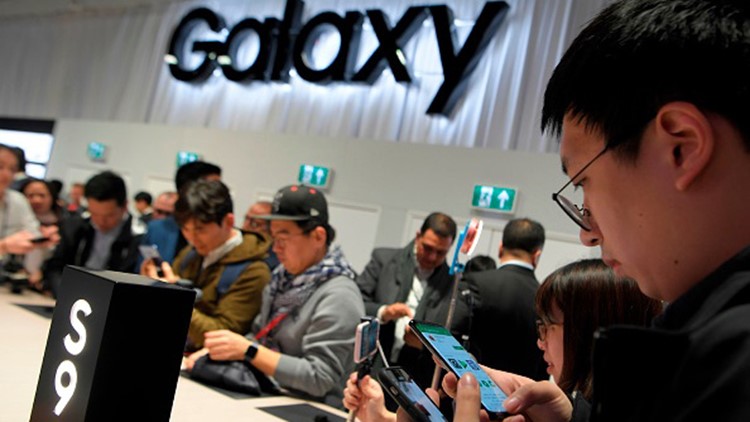Put it this way, Samsung left the radical changes to Apple.
The Galaxy S9 and S9+ smartphones that Samsung introduced at a crowded press gathering here in Barcelona don’t look a whole lot different than last year’s S8 and S8+ handsets. Most of the improvements appear to be incremental. And that’s not necessarily a bad thing.
Apple’s iPhone X represented a major departure compared to earlier iPhone models, most notably with Apple doing away with the Home button and fingerprint sensor. Having to learn new gestures, and coupled with a price tag that cracked $1,000, meant the iPhone X clearly wasn’t for everybody, even some longtime iPhone fans.
Samsung’s latest flagships aren’t cheap either, though at around $720 on up for the S9 and $840 on up for the S9 with various trade-in options and deals to be found, they won’t quite gobble up as much of your disposable income. In that sense, they compete more directly against Apple’s other most recent new phones, the iPhone 8 and 8 Plus.
For sure, Samsung packed its own new phones with the latest robust specs (such as the latest Qualcomm Snapdragon 845 processor) and focused much of its love on the camera system. The larger of the two models, the S9+, gains a second rear camera and both phones promise to perform better in low-light thanks to a dual-aperture lens system. (I’ll judge that myself once I have a review device to test out.)
Both phones also come with 64GB of internal storage, expandable via optional Micro SD cards.
Animoji, meet AR Emoji
Samsung responded to the “animoji” animated emoji feature on the iPhone X with a roughly similar feature I got to quickly try called AR Emojis, in which you can create a 3D model and GIFs that mimic your facial expressions.
Unlike "animojis" that are native to iMessage, Samsung will let you share these AR Emojis through various messaging platforms including WhatsApp. I am curious to pit these two against one another.
The speakers in the new S-series phones are stereo now as well (tuned by AKG Acoustics, with support for Dolby Atmos surround sound as well). And the bezels at the top and bottom of what Samsung refers to as the "Infinity Display" have been reduced ever so slightly, though the curved phablet-sized screens themselves—at 5.8 or 6.2-inches, respectively for the S9 and S9+—are the same size and resolutions as last year when Samsung was also touting the phones’ edge-to-edge designs.
And yes, you can’t help but continue to be impressed by these brilliant displays.
Maybe the biggest thing to cheer design-wise—apart from Samsung retaining the standard headphone jack—is that the company repositioned the fingerprint sensor on the rear of the new phones so that your finger is less likely to inadvertently land on the camera instead, which kept happening to me on last year's flagships.
Besides the fingerprint, you can unlock the display with your iris or through facial recognition, same as before, though the iris and facial methods are now fused together—before a user had to manually choose one method or the other. Security on the phone is handled by the Samsung KNOX system.
A different kind of heat
Samsung faces a very different kind of heat with today’s launch. Eleven months ago when the Korean tech giant unveiled the S8 and S8+ as its first major smartphone releases following the debacle of the thrice-recalled Note 7 that repeatedly caught fire, Samsung had to rebuild its reputation and get past that episode as quickly as possible. The company moved on just fine with the S8 models, and subsequently the Note 8 as well.
So the pressures surrounding the S9 and S9+ launch are of a more routine nature, if no less critical for Samsung. Produce praiseworthy phones that its own customers will like, and maybe get some disillusioned Apple fans to defect.
For many of you, a large part of any such buying decision isn't so much about hardware, but rather still boils down to which mobile operating system you favor, iOS or Android.
Photography is also a major factor, but the truth is the cameras in all the major premium phones of the last year or so have been first rate, with often only subtle (and very subjective) differences in picture quality.
This time around, Samsung says that its speedy dual-pixel camera can combine up to 12 distinct images into one top quality picture. But the most promising advancement seems to be in the aforementioned dual aperture feature, which Samsung says approximates how the human eye works.
Your iris, for instance, opens up wider when you enter a dimly-lit room, or narrows in a brighter environment. That’s how dual aperture works. The camera automatically toggles between F1.5 (the widest aperture ever on a Galaxy) in a low light setting, or F2.4 when you’re in daylight. (In Pro mode you can manually change these settings).
The other new camera addition—this one is kind of fun—is a “super” slow-motion feature that lets you capture video at 960 frames per second, which made a nice effect as I poured a soda can into a cup.
Meanwhile, the S9 and S9+ will be the latest proving ground for Bixby, Samsung’s upstart digital assistant that actually debuted on the S8 and S8+. Bixby has been a laggard compared to the Google Assistant, Amazon’s Alexa, and Apple’s Siri, but Samsung still has high hopes for its own assistant.
For now, I got to try a Bixby feature in which you can aim the camera at a sign in a foreign language and have Bixby translate it into English (or some other designated language). It worked fine. I also had Bixby properly identify the landmarks in postcards showing the Golden Gate Bridge or Mount Rushmore.
Bixby is also meant to fit into Samsung’s broader ecosystem, which includes ambitions in the connected smart home space. Along those lines, the S9 and S9+ come preloaded with the Samsung SmartThings app to serve as a hub for SmartThings-capable light switches, water valves and other connected home products.
The new phones come in three colors in the U.S. (Lilac Purple, Midnight Black and Coral Blue) and sport other long-time Samsung features including fast wireless charging, water and dust resistance, and support for Samsung’s GearVR virtual reality headsets.



